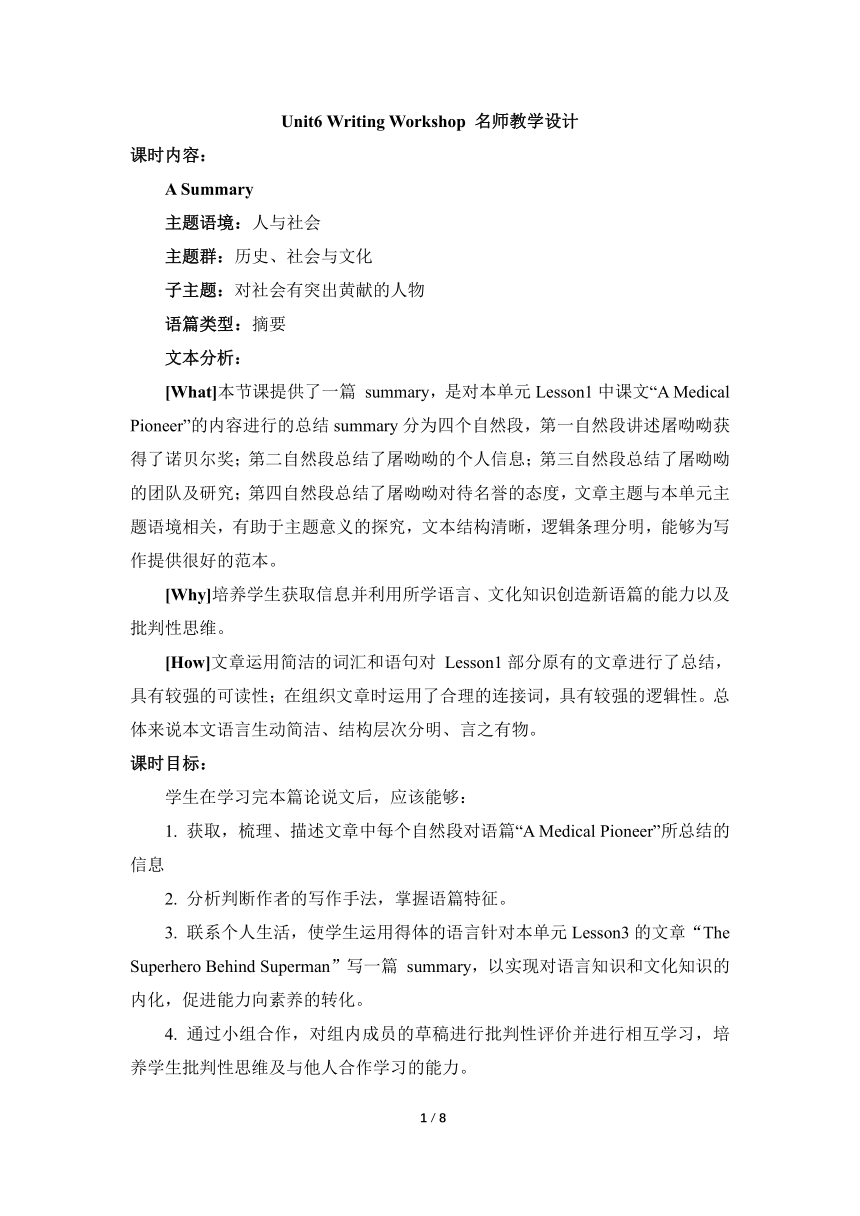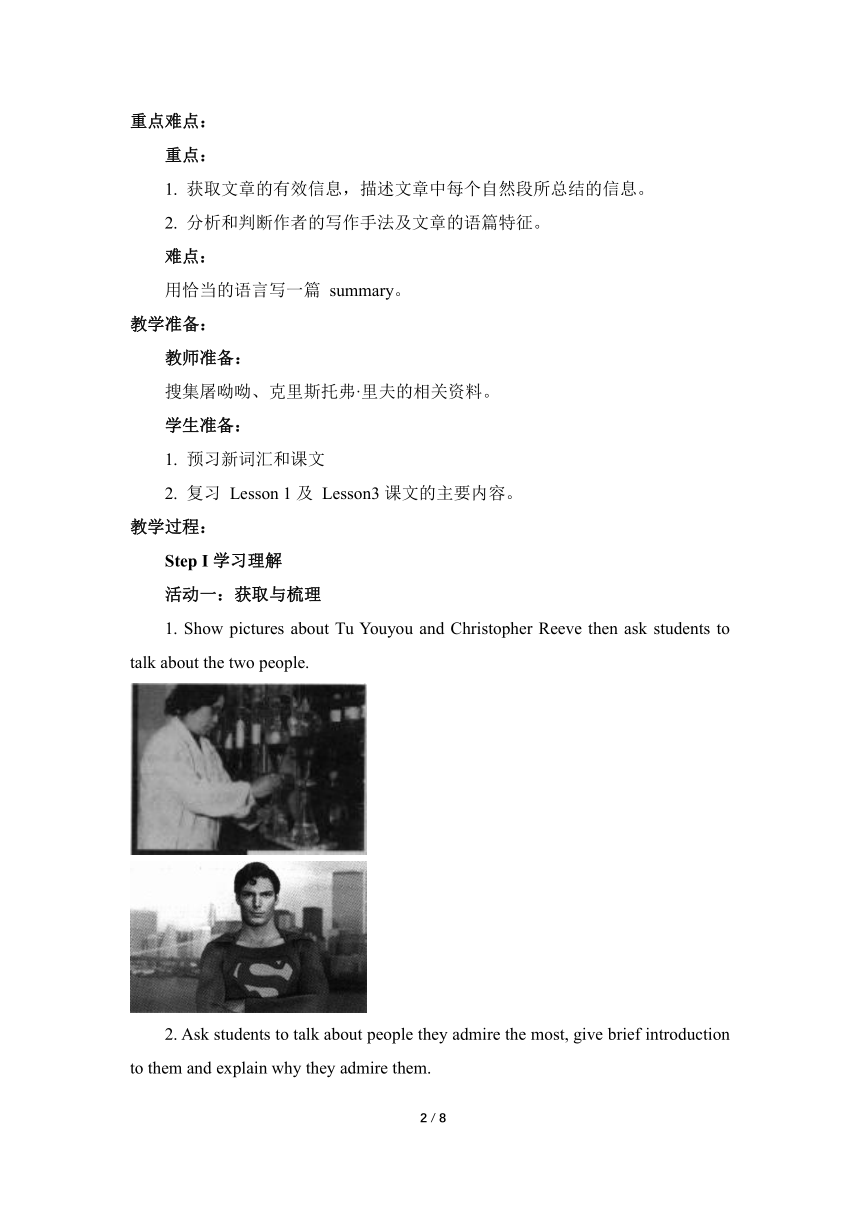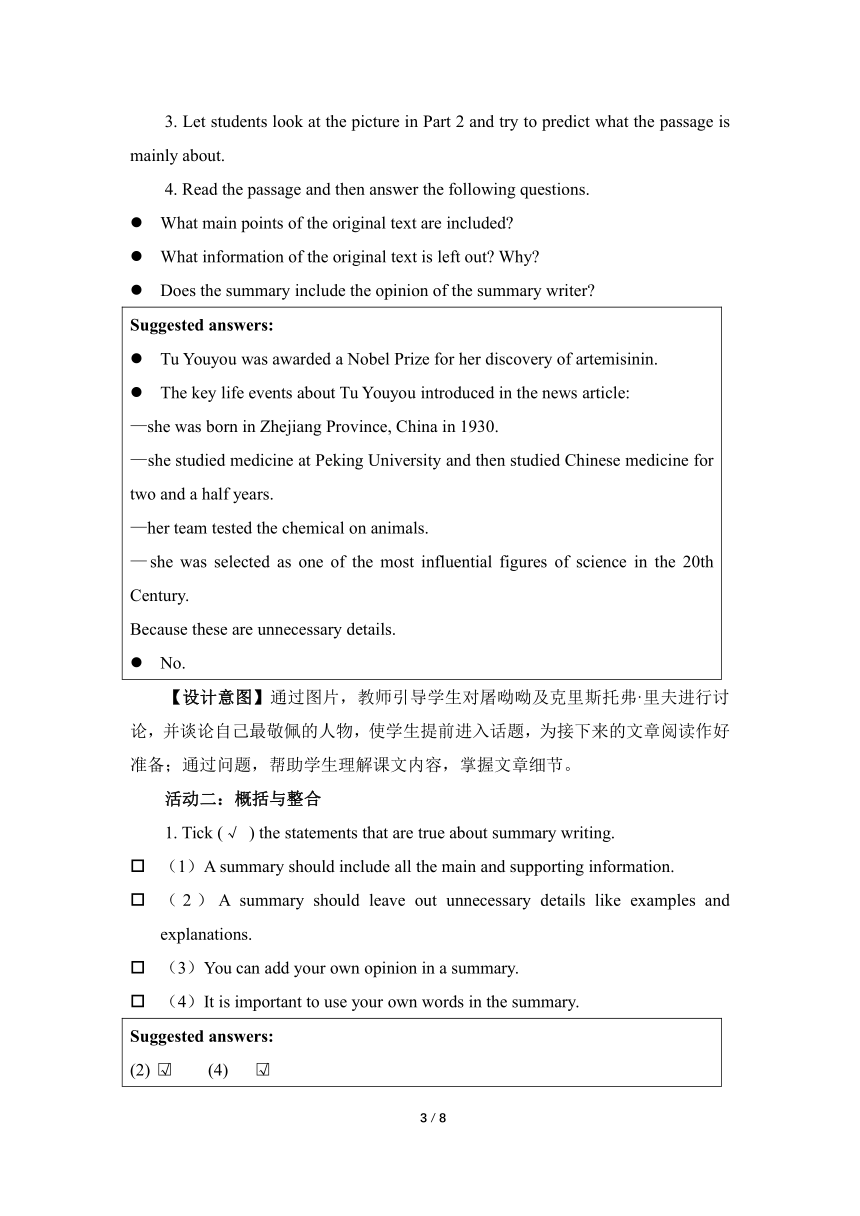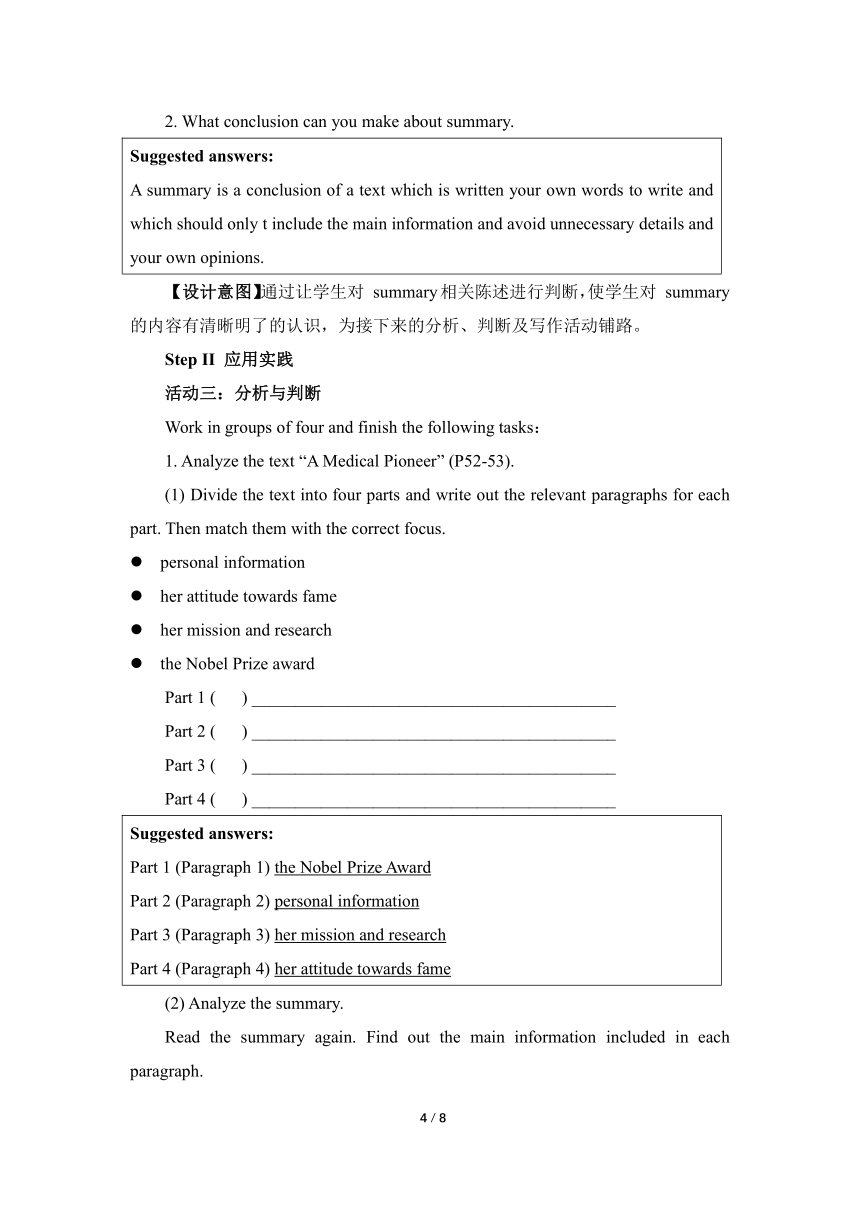北师大版(2019)高中英语必修第二册 Unit6 The admirable Writing Workshop_名师教学设计
文档属性
| 名称 | 北师大版(2019)高中英语必修第二册 Unit6 The admirable Writing Workshop_名师教学设计 |  | |
| 格式 | docx | ||
| 文件大小 | 173.2KB | ||
| 资源类型 | 教案 | ||
| 版本资源 | 北师大版(2019) | ||
| 科目 | 英语 | ||
| 更新时间 | 2023-03-07 18:27:04 | ||
图片预览




文档简介
Unit6 Writing Workshop 名师教学设计
课时内容:
A Summary
主题语境:人与社会
主题群:历史、社会与文化
子主题:对社会有突出黄献的人物
语篇类型:摘要
文本分析:
[What]本节课提供了一篇 summary,是对本单元Lesson1中课文“A Medical Pioneer”的内容进行的总结summary分为四个自然段,第一自然段讲述屠呦呦获得了诺贝尔奖;第二自然段总结了屠呦呦的个人信息;第三自然段总结了屠呦呦的团队及研究;第四自然段总结了屠呦呦对待名誉的态度,文章主题与本单元主题语境相关,有助于主题意义的探究,文本结构清晰,逻辑条理分明,能够为写作提供很好的范本。
[Why]培养学生获取信息并利用所学语言、文化知识创造新语篇的能力以及批判性思维。
[How]文章运用简洁的词汇和语句对 Lesson1部分原有的文章进行了总结,具有较强的可读性;在组织文章时运用了合理的连接词,具有较强的逻辑性。总体来说本文语言生动简洁、结构层次分明、言之有物。
课时目标:
学生在学习完本篇论说文后,应该能够:
1. 获取,梳理、描述文章中每个自然段对语篇“A Medical Pioneer”所总结的信息
2. 分析判断作者的写作手法,掌握语篇特征。
3. 联系个人生活,使学生运用得体的语言针对本单元Lesson3的文章“The Superhero Behind Superman”写一篇 summary,以实现对语言知识和文化知识的内化,促进能力向素养的转化。
4. 通过小组合作,对组内成员的草稿进行批判性评价并进行相互学习,培养学生批判性思维及与他人合作学习的能力。
重点难点:
重点:
1. 获取文章的有效信息,描述文章中每个自然段所总结的信息。
2. 分析和判断作者的写作手法及文章的语篇特征。
难点:
用恰当的语言写一篇 summary。
教学准备:
教师准备:
搜集屠呦呦、克里斯托弗·里夫的相关资料。
学生准备:
1. 预习新词汇和课文
2. 复习 Lesson 1及 Lesson3课文的主要内容。
教学过程:
Step I学习理解
活动一:获取与梳理
1. Show pictures about Tu Youyou and Christopher Reeve then ask students to talk about the two people.
2. Ask students to talk about people they admire the most, give brief introduction to them and explain why they admire them.
3. Let students look at the picture in Part 2 and try to predict what the passage is mainly about.
4. Read the passage and then answer the following questions.
What main points of the original text are included
What information of the original text is left out Why
Does the summary include the opinion of the summary writer
Suggested answers: Tu Youyou was awarded a Nobel Prize for her discovery of artemisinin. The key life events about Tu Youyou introduced in the news article: —she was born in Zhejiang Province, China in 1930. —she studied medicine at Peking University and then studied Chinese medicine for two and a half years. —her team tested the chemical on animals. —she was selected as one of the most influential figures of science in the 20th Century. Because these are unnecessary details. No.
【设计意图】通过图片,教师引导学生对屠呦呦及克里斯托弗·里夫进行讨论,并谈论自己最敬佩的人物,使学生提前进入话题,为接下来的文章阅读作好准备;通过问题,帮助学生理解课文内容,掌握文章细节。
活动二:概括与整合
1. Tick (√ ) the statements that are true about summary writing.
(1)A summary should include all the main and supporting information.
(2)A summary should leave out unnecessary details like examples and explanations.
(3)You can add your own opinion in a summary.
(4)It is important to use your own words in the summary.
Suggested answers: (4)
2. What conclusion can you make about summary.
Suggested answers: A summary is a conclusion of a text which is written your own words to write and which should only t include the main information and avoid unnecessary details and your own opinions.
【设计意图】通过让学生对 summary相关陈述进行判断,使学生对 summary的内容有清晰明了的认识,为接下来的分析、判断及写作活动铺路。
Step II 应用实践
活动三:分析与判断
Work in groups of four and finish the following tasks:
1. Analyze the text “A Medical Pioneer” (P52-53).
(1) Divide the text into four parts and write out the relevant paragraphs for each part. Then match them with the correct focus.
personal information
her attitude towards fame
her mission and research
the Nobel Prize award
Part 1 ( ) __________________________________________
Part 2 ( ) __________________________________________
Part 3 ( ) __________________________________________
Part 4 ( ) __________________________________________
Suggested answers: Part 1 (Paragraph 1) the Nobel Prize Award Part 2 (Paragraph 2) personal information Part 3 (Paragraph 3) her mission and research Part 4 (Paragraph 4) her attitude towards fame
(2) Analyze the summary.
Read the summary again. Find out the main information included in each paragraph.
Paragraph 1: ________________________________
Paragraph 2: ________________________________
Paragraph 3: ________________________________
Paragraph 4: ________________________________
Suggested answers: Paragraph 1: Tu Youyou won the Nobel Prize Award. Paragraph 2: Personal information of Tu Youyou. Paragraph 3: Tu Youyou’s mission and research. Paragraph 4: Tu Youyou’s attitude towards fame.
(3) What conclusion can you make about how to write a summary
Suggested answer: While writing a summary, you should first read the text and divide it into parts, then summarise each part in one or two sentences covering the key information.
2. The writer uses some linking words in the summary.
(1) Find and circle the linking words.
Suggested answers: later, despite, in order to, finally, although
(2) Group Work: work in groups of four and sort out different kinds of linking words you can use to write a summary according to different purposes.
Purpose Linking words
To add something
To show contrast
To explain a reason
To give a result
To show time
To show the purpose
To emphasize
To describe the order of events
Suggested answers:(略)
【设计意图】通过对“A Medical pioneer”原文内容及summary内容进行分析,引导学生对如何写 summary进行总结;寻找文章中的连接词,并根据不同的目的和用途选择连接词,培养学生写作时重视逻辑关系的习惯。这两个活动加深了学生对文章结构及语用知识方面的理解,也为下一步的写作打好语言基础。
活动四:内化与应用
1. Read “The Superhero Behind Superman”
(1) How many parts can it be divided into
Suggested answers: Four parts.
(2) What does each part focus on
Part 1 ( ) ____________________________
Part 2 ( ) ____________________________
Part 3 ( ) ____________________________
Part 4 ( ) ____________________________
Suggested answers: Part 1 (Paragraph 1) general introduction Part 2 (Paragraphs 2-3) life before the accident Part 3 (Paragraphs 4-5) a superhero in real life Part 4 (Paragraph 6) his death
2. Read the following paragraph from the text. What’s the main idea of this paragraph Underline the key words. Summarise the paragraph in one sentence. Do the same for the other parts of the text.
“Reeve starred in four Superman films from 1978 to 1987. He realised that his roles in these films had given him the opportunity to be a real-life superman, and he soon gained a reputation for raising awareness for good causes. He visited sick children in hospitals and worked with organisations such as Save the Children, speaking out about health, education and child protection to help those most in need.”
3. Drafting.
Draft your summary based on the activity above. Use the Writing Help on Page 63 to help you.
【设计意图】本活动为写作实践,在写前设计活动,引导学生对课文“The Superhero Behind Superman”进行分析和划分。以一个自然段为例,让学生划出关键词并用一句话总结段落大意,并依样对文章其他几部分进行概况总结,旨在降低写作难度,增强学生对写作的信心。
Step Ⅲ 迁移创新
活动五:批判与评价
Exchange your draft with a partner.
1. Use the Peer Editing Sheet for Unit 6 on Page 90 to help you review your partner’s draft.
Does the summary cover all the main points
Does the writer leave out unnecessary information
Does the writer use his/her own words
Does the writer use transition words to link the writing
Does the writer use correct grammar, punctuation, or spelling
2. Take your draft back and revise it.
3. Share your essay with the rest of the class.
【设计意图】该环节通过合作的方式,探讨他人的summary是否涵盖了文章主要信息;是否省略了不必要信息;是否用作者自己的语言表述而成;是否使用了合理的连接词以及文章语法、标点、词汇拼写是否正确。从而使学生对组内成员的草稿进行综合评价并相互学习,加深对主题意义的理解和对批判思维及多元思维的培养,实现深度学习。
板书设计:
Unit 6 The Admirable Period V Writing Workshop Ⅰ. 学习理解 活动一:获取与梳理 活动二:概括与整合 Ⅱ. 应用实践 活动三:分析与判断 活动四:内化与应用 Ⅲ. 迁移创新 活动五:批判与评价
2 / 2
课时内容:
A Summary
主题语境:人与社会
主题群:历史、社会与文化
子主题:对社会有突出黄献的人物
语篇类型:摘要
文本分析:
[What]本节课提供了一篇 summary,是对本单元Lesson1中课文“A Medical Pioneer”的内容进行的总结summary分为四个自然段,第一自然段讲述屠呦呦获得了诺贝尔奖;第二自然段总结了屠呦呦的个人信息;第三自然段总结了屠呦呦的团队及研究;第四自然段总结了屠呦呦对待名誉的态度,文章主题与本单元主题语境相关,有助于主题意义的探究,文本结构清晰,逻辑条理分明,能够为写作提供很好的范本。
[Why]培养学生获取信息并利用所学语言、文化知识创造新语篇的能力以及批判性思维。
[How]文章运用简洁的词汇和语句对 Lesson1部分原有的文章进行了总结,具有较强的可读性;在组织文章时运用了合理的连接词,具有较强的逻辑性。总体来说本文语言生动简洁、结构层次分明、言之有物。
课时目标:
学生在学习完本篇论说文后,应该能够:
1. 获取,梳理、描述文章中每个自然段对语篇“A Medical Pioneer”所总结的信息
2. 分析判断作者的写作手法,掌握语篇特征。
3. 联系个人生活,使学生运用得体的语言针对本单元Lesson3的文章“The Superhero Behind Superman”写一篇 summary,以实现对语言知识和文化知识的内化,促进能力向素养的转化。
4. 通过小组合作,对组内成员的草稿进行批判性评价并进行相互学习,培养学生批判性思维及与他人合作学习的能力。
重点难点:
重点:
1. 获取文章的有效信息,描述文章中每个自然段所总结的信息。
2. 分析和判断作者的写作手法及文章的语篇特征。
难点:
用恰当的语言写一篇 summary。
教学准备:
教师准备:
搜集屠呦呦、克里斯托弗·里夫的相关资料。
学生准备:
1. 预习新词汇和课文
2. 复习 Lesson 1及 Lesson3课文的主要内容。
教学过程:
Step I学习理解
活动一:获取与梳理
1. Show pictures about Tu Youyou and Christopher Reeve then ask students to talk about the two people.
2. Ask students to talk about people they admire the most, give brief introduction to them and explain why they admire them.
3. Let students look at the picture in Part 2 and try to predict what the passage is mainly about.
4. Read the passage and then answer the following questions.
What main points of the original text are included
What information of the original text is left out Why
Does the summary include the opinion of the summary writer
Suggested answers: Tu Youyou was awarded a Nobel Prize for her discovery of artemisinin. The key life events about Tu Youyou introduced in the news article: —she was born in Zhejiang Province, China in 1930. —she studied medicine at Peking University and then studied Chinese medicine for two and a half years. —her team tested the chemical on animals. —she was selected as one of the most influential figures of science in the 20th Century. Because these are unnecessary details. No.
【设计意图】通过图片,教师引导学生对屠呦呦及克里斯托弗·里夫进行讨论,并谈论自己最敬佩的人物,使学生提前进入话题,为接下来的文章阅读作好准备;通过问题,帮助学生理解课文内容,掌握文章细节。
活动二:概括与整合
1. Tick (√ ) the statements that are true about summary writing.
(1)A summary should include all the main and supporting information.
(2)A summary should leave out unnecessary details like examples and explanations.
(3)You can add your own opinion in a summary.
(4)It is important to use your own words in the summary.
Suggested answers: (4)
2. What conclusion can you make about summary.
Suggested answers: A summary is a conclusion of a text which is written your own words to write and which should only t include the main information and avoid unnecessary details and your own opinions.
【设计意图】通过让学生对 summary相关陈述进行判断,使学生对 summary的内容有清晰明了的认识,为接下来的分析、判断及写作活动铺路。
Step II 应用实践
活动三:分析与判断
Work in groups of four and finish the following tasks:
1. Analyze the text “A Medical Pioneer” (P52-53).
(1) Divide the text into four parts and write out the relevant paragraphs for each part. Then match them with the correct focus.
personal information
her attitude towards fame
her mission and research
the Nobel Prize award
Part 1 ( ) __________________________________________
Part 2 ( ) __________________________________________
Part 3 ( ) __________________________________________
Part 4 ( ) __________________________________________
Suggested answers: Part 1 (Paragraph 1) the Nobel Prize Award Part 2 (Paragraph 2) personal information Part 3 (Paragraph 3) her mission and research Part 4 (Paragraph 4) her attitude towards fame
(2) Analyze the summary.
Read the summary again. Find out the main information included in each paragraph.
Paragraph 1: ________________________________
Paragraph 2: ________________________________
Paragraph 3: ________________________________
Paragraph 4: ________________________________
Suggested answers: Paragraph 1: Tu Youyou won the Nobel Prize Award. Paragraph 2: Personal information of Tu Youyou. Paragraph 3: Tu Youyou’s mission and research. Paragraph 4: Tu Youyou’s attitude towards fame.
(3) What conclusion can you make about how to write a summary
Suggested answer: While writing a summary, you should first read the text and divide it into parts, then summarise each part in one or two sentences covering the key information.
2. The writer uses some linking words in the summary.
(1) Find and circle the linking words.
Suggested answers: later, despite, in order to, finally, although
(2) Group Work: work in groups of four and sort out different kinds of linking words you can use to write a summary according to different purposes.
Purpose Linking words
To add something
To show contrast
To explain a reason
To give a result
To show time
To show the purpose
To emphasize
To describe the order of events
Suggested answers:(略)
【设计意图】通过对“A Medical pioneer”原文内容及summary内容进行分析,引导学生对如何写 summary进行总结;寻找文章中的连接词,并根据不同的目的和用途选择连接词,培养学生写作时重视逻辑关系的习惯。这两个活动加深了学生对文章结构及语用知识方面的理解,也为下一步的写作打好语言基础。
活动四:内化与应用
1. Read “The Superhero Behind Superman”
(1) How many parts can it be divided into
Suggested answers: Four parts.
(2) What does each part focus on
Part 1 ( ) ____________________________
Part 2 ( ) ____________________________
Part 3 ( ) ____________________________
Part 4 ( ) ____________________________
Suggested answers: Part 1 (Paragraph 1) general introduction Part 2 (Paragraphs 2-3) life before the accident Part 3 (Paragraphs 4-5) a superhero in real life Part 4 (Paragraph 6) his death
2. Read the following paragraph from the text. What’s the main idea of this paragraph Underline the key words. Summarise the paragraph in one sentence. Do the same for the other parts of the text.
“Reeve starred in four Superman films from 1978 to 1987. He realised that his roles in these films had given him the opportunity to be a real-life superman, and he soon gained a reputation for raising awareness for good causes. He visited sick children in hospitals and worked with organisations such as Save the Children, speaking out about health, education and child protection to help those most in need.”
3. Drafting.
Draft your summary based on the activity above. Use the Writing Help on Page 63 to help you.
【设计意图】本活动为写作实践,在写前设计活动,引导学生对课文“The Superhero Behind Superman”进行分析和划分。以一个自然段为例,让学生划出关键词并用一句话总结段落大意,并依样对文章其他几部分进行概况总结,旨在降低写作难度,增强学生对写作的信心。
Step Ⅲ 迁移创新
活动五:批判与评价
Exchange your draft with a partner.
1. Use the Peer Editing Sheet for Unit 6 on Page 90 to help you review your partner’s draft.
Does the summary cover all the main points
Does the writer leave out unnecessary information
Does the writer use his/her own words
Does the writer use transition words to link the writing
Does the writer use correct grammar, punctuation, or spelling
2. Take your draft back and revise it.
3. Share your essay with the rest of the class.
【设计意图】该环节通过合作的方式,探讨他人的summary是否涵盖了文章主要信息;是否省略了不必要信息;是否用作者自己的语言表述而成;是否使用了合理的连接词以及文章语法、标点、词汇拼写是否正确。从而使学生对组内成员的草稿进行综合评价并相互学习,加深对主题意义的理解和对批判思维及多元思维的培养,实现深度学习。
板书设计:
Unit 6 The Admirable Period V Writing Workshop Ⅰ. 学习理解 活动一:获取与梳理 活动二:概括与整合 Ⅱ. 应用实践 活动三:分析与判断 活动四:内化与应用 Ⅲ. 迁移创新 活动五:批判与评价
2 / 2
同课章节目录
- Unit 4 Information technology
- Lesson 1 Avatars
- Lesson 2 Apps
- Lesson 3 Internet and Friendships
- Unit 5 Humans and nature
- Lesson 1 A Sea Story
- Lesson 2 Professional Rescue Team
- Lesson 3 Race to the Pole
- Unit 6 The admirable
- Lesson 1 A Medical Pioneer
- Lesson 2 History Makers
- Lesson 3 The Superhero Behind Superman
